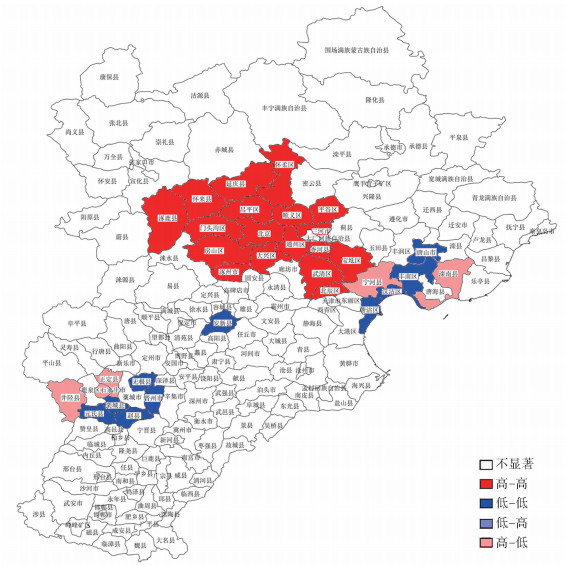Economic Spatial Pattern at Country Level in Beijing-Tianjin-Hebei Region
-
摘要: 旨在探讨京津冀县域经济发展空间格局变化情况并分析原因。选取京津冀174个县域单元作为研究对象,运用探索性空间方法分析2006—2016年县域经济发展规模和结构空间格局的演变规律。研究发现:京津冀县域经济规模和结构差异呈现显著的阶段性变化趋势;县域经济发展两极分化明显,县域人均GDP和第三产业生产总值比率有显著的空间正自相关性,呈现出空间集聚分布和典型的“核心-边缘”格局;区域经济空间发展轴格局初步形成,各功能区形成符合各自功能定位的经济发展特点。经济发展基础、区域经济政策和地理区位条件是影响京津冀县域经济格局的主要因素。最后提出了依据京津冀区域战略功能定位,优化经济结构和协同发展的政策建议。Abstract: The article aims to explore the changes in the spatial pattern of regional economic development in Beijing-Tianjin-Hebei region and analyze the reasons. We analyzes the evolution of the spatial pattern of economic development scale and structure from 174 county units in Beijing-Tianjin-Hebei region from 2006 to 2016 by the exploratory spatial method. It is found that the differences in regional economic scale and structure of Beijing-Tianjin-Hebei region have a significant trend of changing in stages. The polarization of county economic development is obvious and the ratio of per capita GDP and tertiary industry GDP have significant, positive spatial autocorrelation, showing the spatial agglomeration distribution and the typical "core-edge" pattern. The pattern of spatial development axis of regional economy has been formed gradually and each functional area develops an economic development characteristic that conforms to the functional positioning of its own.The paper suggests that the main factors affecting the regional economic pattern in Beijing-Tianjin-Hebei region are economic development foundation, regional economic policy and geographical location.Finally, we put forward the policy recommendations for the structural optimization and coordinated development according to strategic function of Beijing-Tianjin-Hebei region.
-
京津冀区域作为最具活力、人口最多、创新力最强、开放度最高的地区之一,在中国主要经济区中具有重要的战略地位和独特性。2006年,国家发展和改革委员会正式启动了京津冀都市圈规划的编制工作,京津冀区域发展问题正式纳入“十一五”规划。2011年,“十二五”规划提出“建设首都经济圈”,进一步推进京津冀经济一体化发展的要求。2014年,非首都功能疏解政策提出,京津冀协同发展上升为重大的国家战略。2017年9月发布的新版《北京城市总体规划(2016年—2035年)》中,明确指出要发挥北京市的辐射带动作用,携手天津、河北共同打造以首都为核心的世界级城市群,优化京津冀空间格局,以“一核、双城、三轴、四区、多节点”为骨架,构建以重要城市为支点,以战略性功能平台为载体,以交通干线、生态廊道为纽带的网络型空间格局。新版规划对京津冀区域未来20年的空间格局和战略定位给出了明确的要求。区域经济空间格局作为一定区域范围内经济要素的分布形式和经济活动的空间表现形式,一方面反映了区域发展的本质状态,另一方面,经济格局变化也可以反映区域经济政策的具体实施效果。因此,分析京津冀县域经济发展空间格局,有助于了解京津冀经济活动的空间演变规律以及京津冀经济一体化发展政策的实施效果,对促进京津冀协同发展具有重大的意义。
区域经济空间格局变化是区域经济学和经济地理学领域共同关注的热点问题。关于区域经济空间格局的理论研究国外开始较早,包括佩鲁[1]的“区域经济增长极”理论、缪尔达尔等[2]的“循环积累论”、赫希曼[3]的“极化-涓滴”理论、弗兰克[4]的“依赖”理论、布鲁克弗尔德[5]的“相互依赖”理论、弗里德曼[6]的“核心-边缘”理论等。近年国内学者在经济空间格局理论研究方面也有丰富的研究成果,陆大道[7]提出的“点-轴”理论,建立了区域经济“T”型发展结构;陆玉麒[8]通过对区域中心城市与港口城市对应关系的考察提出了区域“双核结构”模式。这些理论研究为开展区域经济空间格局研究提供了理论范式和方法支持。部分学者在实证研究领域也取得进展,学者主要从历史演变[9-11]、空间差异[12-14]、机理分析[15-17]等方面展开研究,研究方法主要采用差异分析法、变异系数法、空间统计方法、因子分析法、断裂点法等[18-22]。这些研究成果为了解区域经济发展现状,进一步制定区域经济发展政策提供了科学依据。
总结现有的相关研究成果存在如下3个特点:①研究尺度从全国范围逐渐转移到省域范围,主要集中在对经济较发达城市、东中西三大发展地区、重要经济区开展研究,从县域层面分析重要经济区的经济空间格局的研究较少,较小尺度的空间单元对宏观经济的波动更为敏感,针对县域单元选择合理的方法分析区域经济的空间格局变化更为合理。②研究方法和指标的选择,现有研究采用的传统分析方法没有考虑研究对象的地理空间分布特征和位置关系,可视化水平较低,但空间统计方法可以更好地解决该问题。由于衡量经济发展较为成熟的指标体系尚未确立,使用多指标评价经常存在分析结果不稳定等问题,又因县级单位很难获得大规模和长期的数据,单一指标克服了该不足。③关于区域经济空间格局演变的研究绝大多数仅分析经济规模发展格局,较少研究考虑经济结构空间格局。本文在此基础上,选择了重要经济区中最有代表性的京津冀区域,从县域层面运用GIS空间统计方法,研究京津冀区域内经济差异和经济集聚现象,探讨京津冀经济空间格局的演变规律,为优化区域经济空间结构提供依据。
一. 研究区域及数据选取
一 研究区域概况
根据国家“十一五”规划制定的《京津冀都市圈区域规划》,京津冀区域包括北京市、天津市以及河北省11个地级市,其中北京、天津,以及河北的保定、廊坊为中部核心功能区。截至2017年底,京津冀区域经济总量约为8.25万亿元,占全年国内生产总值的9.97%,人口约1.1亿,占全国总人口7.91%,区域面积21.5 km2,占国土面积的2.24%[23],在我国发展的总体布局中发挥着重要作用。
二 数据来源
本文研究的区域包括北京地区、天津地区和河北省全部地区。为便于研究,本文以2016年京津冀区域行政区划为标准,共选取174个区域单位,考虑到地级市研究数据的可获得性和各区之间的相似性,市区被视为独立的研究单位。时间范围为2006—2016年,选择2006年数据作为基期,对其余年份数据按可比价格换算。研究对象选择地区人均GDP作为经济规模变量。本文对于区域经济结构的研究主要针对产业结构,根据库茨涅兹提出的产业结构演变规律,经济发展往往伴随产业结构的高级化,具体表现为第三产业逐步上升为国民经济的主导产业[24]。《京津冀协同发展规划纲要》和《北京城市总体规划(2016年—2035年)》从功能定位角度对京津冀三地产业结构调整做出了明确要求,第三产业生产总值比率可以代表产业结构的优化程度。因此本文选择第三产业生产总值比率作为经济结构变量。研究相关数据资料来自2007—2017年《中国城市统计年鉴》《北京统计年鉴》《河北经济年鉴》《天津统计年鉴》。
二. 研究方法
为探讨京津冀县域经济发展的空间格局变化,本文选择使用变异系数法、全局空间自相关分析方法和局部空间自相关分析方法进行研究。
一 变异系数
变异系数(Cv)可以反映单位平均值的离散程度,并且消除了变量数量水平的影响。该指标可以度量区域发展差异的程度。该公式如下:
$$ {C_v} = \frac{1}{{\bar x}}\sqrt {\frac{1}{{n -1}}\sum\limits_{i = 1}^n {\left( {{x_i} -\bar x} \right)} } $$ (1) 式中:xi为第i个研究单元的观测值,n为研究单元的数量,x为n个研究单元观测值均值。
二 全局空间自相关分析
全局空间自相关系数可以衡量整个地区属性值空间分布情况,全局Moran's I(莫兰指数)统计量通常用于度量区域全局空间的自相关性。具体公式如下:
$$ I = \frac{{n\sum\limits_{i = 1}^n {\sum\limits_{j = 1}^n {{w_{ij}}} } \left( {{x_i} -\bar x} \right)\left( {{x_j} -\bar x} \right)}}{{\left( {\sum\limits_{i = 1}^n {\sum\limits_{j = 1}^n {{w_{ij}}} } } \right)\sum\limits_{i = 1}^n {{{\left( {{x_i} -\bar x} \right)}^2}} }} $$ (2) 式中:n表示县级区域单元数量,xi和xj分别表示i和j区域的空间变量,x为均值,wij为空间权重矩阵W中的元素,具体形式为:
$$ \boldsymbol{W}=\left[\begin{array}{ccc}{w_{11}} & {\cdots} & {w_{1 n}} \\ {w_{21}} & {\cdots} & {w_{2 n}} \\ {\vdots} & {} & {\vdots} \\ {w_{n 1}} & {\cdots} & {w_{n n}}\end{array}\right] $$ (3) 式中:n表示空间区域单元数量,如果i单元与j单元相邻,wij=1,否则wij=0,如果i=j,wij取值也为0。Moran's I指数的值介于-1与1之间,值越接近于1,总体空间差异越小。在给定的显著性水平下,若Moran's I值显著为正,表明区域经济总体自相关性为正,说明经济发展水平较高或较低的区域在空间上显著集聚;若Moran's I值显著为负,表明区域经济的总体自相关性为负,说明某区域与其周边区域的经济发展水平存在显著的空间差异。构造标准化的检验统计量Z检验全局空间自相关系数的显著性,公式为:
$$ Z(I)=\frac{I-E(I)}{\sqrt{\operatorname{Var}(I)}} $$ (4) 式中:I为计算得到的全局Moran's I指数,E(I)为全局Moran's I指数的数学期望,Var(I)为全局Moran's I指数的方差。
三 局部空间自相关分析
局部空间自相关分析主要测量各区域与周边区域的局部空间相关程度和空间差异,并结合地图形式,可视化局部差异的空间结构,进而发现区域的空间分布规律。局部Moran's I(统计量作为空间关联局域指标(local indicators of spatial association, 简称LISA)通常用于衡量局部空间的自相关性,公式如下:
$$ {I_i} = \frac{{\left( {{x_i} -\bar x} \right)}}{{\sum\limits_i {{{\left( {{x_i} -\bar x} \right)}^2}} }}\sum\limits_j^n {{w_{ij}}} \left( {{x_j} -\bar x} \right) = {Z_i}\sum\limits_j^n {{w_{ij}}} {Z_j} $$ (5) 式中:Zi和Zj分别为区域i和相邻j区域空间变量的标准化值,xi代表区域i的空间变量,x表示均值,n表示空间区域单元数量,wij是空间权重矩阵W的元素,$ \sum\limits_{j}^{n} w_{i j} Z_{j}$被称为空间滞后向量,是相邻区域空间变量偏差的加权平均值。构造标准化的检验统计量Z检验局部空间自相关系数的显著性,公式为:
$$ Z\left(I_{i}\right)=\frac{I_{i}-E\left(I_{i}\right)}{\sqrt{\operatorname{Var}\left(I_{i}\right)}} $$ (6) 式中:Ii为计算得到的局部Moran's I指数,E(Ii)为局部Moran's I指数的数学期望,Var(Ii)为局部Moran's I指数的方差。
三. 研究结果
一 京津冀县域经济格局全局空间分析
利用ArcGIS 10.4和GeoDa软件计算京津冀人均GDP和第三产业GDP比率的空间自相关分析指标,其中人均GDP作为经济规模变量, 第三产业GDP比率作为经济结构变量。根据公式(1)计算变异系数(人均GDP为各地区经济规模的观测值,第三产业GDP比率为各地区经济结构的观测值),根据公式(2)、(3)计算全局Moran's I指数,并根据公式(4)Z值法检验全局空间自相关性,根据公式(5)计算局部Moran's I指数,并根据公式(6)Z值法检验局部空间自相关性,全局空间相关分析计算结果如表 1所示。
表 1 京津冀县域经济发展变异系数和全局空间自相关系数年份 人均GDP(代表经济规模) 第三产业GDP比率(代表经济结构) Global Moran's I Z值 Sig 变异系数 Global Moran's I Z值 Sig 变异系数 2006 0.447 9.870 0.001 0.832 0.255 5.478 0.001 0.291 2007 0.431 9.578 0.001 0.859 0.251 5.400 0.001 0.299 2008 0.382 8.491 0.001 0.739 0.241 5.188 0.001 0.376 2009 0.434 9.356 0.001 0.727 0.199 4.372 0.001 0.325 2010 0.308 6.711 0.001 0.695 0.243 5.154 0.001 0.313 2011 0.358 6.667 0.001 0.679 0.165 3.593 0.001 0.331 2012 0.319 6.786 0.001 0.659 0.283 6.072 0.001 0.332 2013 0.318 6.710 0.001 0.668 0.277 5.971 0.001 0.324 2014 0.315 6.708 0.001 0.688 0.246 5.253 0.001 0.288 2015 0.380 7.819 0.001 0.659 0.216 4.706 0.001 0.304 2016 0.372 7.656 0.001 0.647 0.210 4.572 0.001 0.298 表 1中变异系数计算结果表明,京津冀县域经济规模和结构差异在3个阶段呈现不同的变化规律:2006—2010年,人均GDP变异系数呈下降趋势,京津冀县域经济规模的相对差异逐年递减,第三产业GDP比率变异系数明显增加,经济结构差异增大;2010—2014年,人均GDP变异系数值基本保持稳定,呈缓慢上升趋势,京津冀县域经济规模差异扩大,第三产业GDP比率变异系数逐年下降,经济结构差异缩小;2014—2016年人均GDP变异系数值下降,京津冀县域经济规模差异缩小,第三产业GDP比率变异系数回升,经济结构差异进一步扩大。京津冀县域经济规模差异在研究期整体呈缩小趋势,分阶段呈现出缩小—扩大—缩小的变化规律,结构差异在研究期内整体呈现增大趋势,分阶段呈现出扩大—缩小—扩大的变化规律。
全局Moran's I指数计算结果表明,2006—2016年间所有Moran's I值为正,均通过0.001显著性水平检验,京津冀区域经济规模和结构呈显著的空间自相关性,即经济发展高水平的区域在空间范围上存在集聚倾向,同时经济发展落后的区域在空间上也存在集聚倾向。京津冀县域经济规模全局Moran's I值变化分3个阶段:2006—2009年,Moran's I值缓慢上升,2009年达到峰值,表明京津冀县域经济的空间集聚度增强,经济规模的区域差距在缩小;Moran's I值在2009—2014年下降,县域经济规模集聚度减弱,经济规模的差异扩大;2014—2016年,Moran's I值大幅上升,县域经济规模的空间集聚度增加,经济规模区域差异再次呈现缩小趋势。京津冀县域经济结构全局Moran's I值的变化也分几个阶段:2006—2009年,Moran's I值呈下降趋势,京津冀县域经济结构的空间集聚度减弱,经济结构的区域差异在扩大;2009—2014年,Moran's I值逐年上升,经济结构集聚度增加,经济结构区域差异有减弱趋势;2014—2016年经济结构Moran's I值下降,县域经济结构在这一阶段空间集聚度减弱,不同区域间经济结构发展差异进一步加剧(见表 1)。研究期内京津冀县域单元经济规模和结构发展均表现出明显的集聚特征,经济规模集聚度在研究期整体增强,分阶段呈现出增强—减弱—增强的变化规律;结构集聚度在研究期平稳波动,分阶段呈现出减弱—增强—减弱的变化规律。
综上,变异系数和全局Moran's I指数计算结果一致,表明研究期内经济规模和结构发展水平相近的区县在时间范围内集中分布在2006—2009年期间,县域经济规模发展差异缩小,经济结构发展差异扩大,县域经济结构呈现不平衡的发展格局;2009—2014年期间,县域经济规模发展差异扩大,经济结构发展差异缩小,县域经济规模呈现不平衡发展格局,经济结构发展的不平衡现象有所缓解;2014年京津冀协同发展战略提出后,经济规模差异显著降低,经济结构差异持续扩大,各区县间经济规模发展的空间趋同性增强,经济结构发展的不平衡有扩大趋势。
二 京津冀县域经济格局局部空间分析
结合变异系数和全局Moran's I指数分阶段变化规律,考虑2006年为“十一五”规划开始年份,“十一五”规划期间正式启动京津冀都市圈规划编制,2014年为京津冀区域一体化和非首都功能疏解区域政策提出的重要年份,本文选择2006、2010、2014、2016年4个时间节点,绘制了京津冀县域经济规模和结构在0.05显著性水平下的LISA集聚图并分析结果(见图 1~8)。在图 1~8中,高-高型(HH)代表高观测值区域与同样高观测值区域相邻的空间格局类型,低-低型(LL)代表低观测值区域与相同低观测值的区域相邻,低-高型(LH)代表低观测值区域周围存在高观测值区域,高-低型(HL)代表高观测值区域周围存在低观测值区域。
LISA集聚图表明京津冀县域经济发展的空间格局演变具有以下特点:
1) 京津冀县域经济规模和经济结构发展两极分化明显,空间格局表现出明显的“核心-边缘”发展特征。HH型和LL型的区县数量呈现绝对优势,2006—2016年,县域经济规模发展格局为HH型的区县由13个增加为23个,高水平集聚地区数量明显扩张,LL型区县由24个减少为22个,低集聚地区数量保持平稳;县域经济结构发展格局为HH型的区县由16个减少为14个,经济结构也呈现高水平集聚特征,LL型区县由4个增加为12个,低集聚地区数量有不断扩大的趋势。京津冀县域经济规模和经济结构空间格局均呈现出自身水平高周围地区发展水平高、自身水平低周围地区发展水平低的两个“俱乐部”格局,经济空间格局极化特征明显。京津冀区域作为北部经济重心,目前形成了3个超高速增长集聚区:①北京的核心6区及周边地区;②天津沿海地区;③唐山地区。与此同时,河北中南部地区发展较缓慢,石家庄北部、保定西南部、邢台中部和东部,以及衡水南部形成集中的边缘化发展地区,在京津冀区域整体发展的过程中这两类地区逐渐拉开差距,形成了空间范围的“核心-边缘”发展格局。
2) 京津冀区域经济空间发展轴格局初步形成。图 1~4显示:2006年,13个HH型区县在京津地区形成了1个HH型集聚区,对周边地区产生较强的经济辐射效应,京津发展轴形成;2010年,增加了由东部唐山市滦南县、滦县等区县形成的HH型集聚区,京唐秦发展轴形成;2014年,京津集聚区范围扩大,增加了天津的静海区、武清区,河北的沧州市和廊坊市的部分区县;2016年,京津集聚区进一步扩大,与唐山HH型集聚区合并为一个增长极,冀南石家庄市和正定县部分区域形成了另一个HH型区域,京石保发展轴初步形成。2006年,京津冀西北部张家口市、西部保定市、南部衡水市形成3个LL型集聚区,这3个区域经济发展规模较其他县域相对落后;2016年,西部LL型集聚区面积扩大,南部集聚区没有发生重大变化。从图 5~8可以看出:2006年,张家口—北京集聚区经济结构集聚性较强,经济结构发展较好;2014年,经济结构发展程度较高的区域延伸至天津和河北的东部地区;2016年HH型集聚区范围逐渐缩小,只有京津发展轴表现出较高的经济结构发展水平;2010年,LL型区县主要集中在天津滨海新区;2014年LL型集聚区增加了石家庄栾城县、晋州市;2016年京石保发展轴经济结构发展呈现显著的LL型集聚特征。
结果显示,京津冀区域经济三大发展轴空间格局已经初步形成,其中京津发展轴形成较早,经济规模和结构发展水平较高,京唐秦发展轴经济规模快速扩张,但产业结构转型较慢,京石保发展轴于2016年形成,仅石家庄地区形成了增长极,保定、邢台等地区仍停留在经济发展水平相对落后,差距持续扩大的状态。京津冀区域经济规模发达区域发挥的辐射带动作用明显,经济结构发展较好区域辐射作用较弱。
3) 京津冀区域各功能区形成符合各自功能定位的经济发展特点。中部北京市、天津市、河北的廊坊和保定市的部分地区在研究期内经济规模和结构都呈现HH型集聚特征。东部天津、河北沿海地区经济规模HH型区域面积逐渐扩大,但经济结构仍保持显著LL型集聚特征。主要的经济规模和结构LL型集聚区都在南部石家庄、邯郸、邢台市和衡水地区。西北部河北张承地区和北京市山区、天津市山区,经济规模LL型集聚特征减弱,经济结构发展从2010年开始呈现出显著的HH型集聚特征。
结合京津冀区域协同发展目标和各地区比较优势,《北京城市总体规划(2016年—2035年)》将京津冀区域划分为中部核心功能区、东部滨海发展区、南部功能拓展区、西北部生态涵养区4个功能区。研究结果显示,4个区域产业发展优化程度存在明显差异,与《北京城市总体规划(2016年—2035年)》中功能区的战略定位呈现出一定程度的一致性。中部核心功能区是带领京津冀协同发展的核心区域,经济规模和经济结构一直保持较高的发展水平,持续带动周围区域发展;东部滨海发展区有较好的地理区位条件和工业发展基础,经济规模扩张迅速,但产业结构以化工业为主,经济结构发展水平较低;南部功能拓展区处于京津冀区域边缘,长期停留在发展水平较低的阶段,区域整体发展动力不足,缺乏带动性增长;西北部生态涵养区低水平集聚效应减弱,呈现出较高的产业结构发展水平,生态保护、水源涵养相关旅游和绿色产业发展在拉动经济规模增长的同时促进了产业结构优化。
三 京津冀县域经济空间格局驱动因素
区域经济发展系统复杂,影响因素众多,本文基于实证分析的结果,考虑到京津冀区域历史发展、战略定位和地理位置的特殊性,从经济发展基础、区域发展政策和地理区位条件3方面分析京津冀县域经济空间格局的驱动因素。
1 经济发展基础
缪尔达尔的“循环累积因果”理论认为区域经济发展会导致初始资本累积,“回波效应”会强化这种经济因素,导致经济沿着初始因素变化的方向发展,现阶段的经济格局往往是发展继承了历史经济格局。因此,较好的经济发展基础是京津冀县域经济空间格局演变的主要动力之一,良好的要素资源禀赋、能源储备、基础设施等因素是北京市、天津市快速发展的重要条件。其他地区在历史上由于资源要素等发展条件薄弱,生产力水平低下,落后的经济基础进一步导致了现经济阶段的滞后发展。
2 区域发展政策
区域发展政策是区域经济结构演变的重要推动力之一。为了促进区域经济协调发展,国家从“十一五”规划开始制定实施了一系列京津冀经济合作的政策和协议。这些政策的实施对于区域生态环境改善、资本流通渠道拓宽、交通等基础设施建设、产业结构转型和优化升级产生了积极的影响。技术进步也促进了经济的快速发展和良性循环,使得区县间差距逐渐缩小,进一步促进了京津冀经济协调发展。但是,由于京津冀区域经济“中央力量”对周边地区产生的巨大虹吸效应,大量资源、劳动力向中部发达地区聚集,使该区域与边缘其他区县经济发展水平差距日益加大,空间极化现象阻碍了边缘地区的经济发展。另一方面,由于国家发展规划对各区域功能定位做出了明确要求,河北张家口、承德、保定、石家庄、邢台,以及邯郸西部部分区县,北京西北部分区县承担了京津冀区域生态涵养功能,在生态建设和水源保护方面做出了重要的贡献。尽管国家也建立了相应的生态补偿机制,但补偿机制不完善、基础设施落后、产业发展受到限制必然会对现有区域经济发展空间格局产生影响。
3 地理区位条件
区位条件是京津冀县域经济发展水平的重要影响因素之一,通过影响生产要素的流动与优化配置引起经济增长分异。津唐地区发展成为京津冀区域经济发展的集聚中心,一定程度上得益于较好的区位条件。北京市、天津市与河北唐山市均位列42个全国性综合交通枢纽城市。便捷的交通条件,衔接了多种运输方式,促进了京津唐增长中心的空间极化效应。与核心发展区域相比,河北衡水南部地区和邢台东部地区只有一条省级铁路干线,区位条件较差,同时受地貌条件的限制,基础设施建设落后,交通不便,与周边区域物质、信息的交流较为缺乏,受外部的人才、科技及信息的影响较小,发展速度较为缓慢。
四. 结论与建议
一 结论
本文以京津冀174个县域单元为研究对象,选取人均GDP和第三产业GDP比率作为经济发展评价指标,通过ArcGIS 10.4和GeoDa软件计算2006—2016年的变异系数、全局Moran's I指数及2006、2010、2014、2016年4个时间节点的局部Moran's I指数,并绘制了京津冀人均GDP和第三产业GDP比率的LISA集聚图,可视化研究了京津冀县域经济空间格局的演变。结论如下:全局相关分析显示,县域经济发展空间格局呈阶段性变化,2014年京津冀协同发展战略提出后,区域整体经济规模差异显著降低,县域间经济规模空间协同作用有增强趋势,经济结构差异持续扩大;局部相关分析显示,京津冀县域经济规模和经济结构发展两极分化明显,经济发展空间格局呈现高水平集聚特征,经济发达县域集中在北京、天津,河北唐山、秦皇岛地区,低集聚地区主要集中在南部保定、邯郸、邢台地区,数量有不断扩大的趋势。京津冀区域经济三大发展轴空间格局已经初步形成,其中京津冀南部地区京石保发展轴发展水平较低。京津冀区域各功能区针对各自的战略定位和发展目标,呈现出符合各区功能定位的经济发展特点。经济发展基础、地理位置条件和区域发展政策是影响京津冀区域经济发展空间格局的主要因素。
二 建议
根据研究结论可以看出,京津冀县域经济发展空间格局变化反映了区域经济发展的非均衡现状,京津冀县域经济规模差异得到了较大程度的改善,但县域整体经济结构发展水平较低,县域间差异较大,同时经济发展集中连片的落后区域以及南部功能拓展区发展滞后等问题都极大程度制约了京津冀区域协同发展。下一阶段应当依据《京津冀协同发展规划纲要》提出的具体要求,大力推进县域经济产业结构优化进程,缩小经济低速发展集聚区域面积,发展新的区域经济增长极,突出各区域战略功能定位,重点扶持南部功能拓展区和西北部生态涵养区发展。具体建议如下:
1) 针对经济结构发展水平较低、区域差异较大的现状,各区域应当将发展方向集中在创新改造传统产业,同时大力发展新兴产业和现代化服务业。京津冀县域经济结构发展分异现象严重,中东部地区产业结构优化程度一直保持在较高水平,结合京津冀战略功能定位,冀南地区成为了经济结构转型的重点发展区域。对于以传统钢铁化工等重工业为主的地区,不仅需要控制传统产业经济规模,更应该利用技术创新改造传统产业,在未来发展中加大对建材、石化等传统产业技术创新和改造,提供高技术含量钢铁产品的供给,考虑将工业产品精加工作为转型的主要方向。同时增加战略性新兴产业的投入力度,扩大商业服务、信息技术等科技密集型服务业比例,结合物流业的发展需求和南部地区区位交通发展条件,在下一步发展过程中加快商贸物流基地建设,推进物流标准化和现代化,创建京津冀协同、国内外连通的现代物流网络体系,利用多种方式调整产业内部结构。
2) 应当大力发挥发达区域经济辐射作用,并着力开发新的经济增长极。京津冀区域南部存在大面积集中连片的经济发展缓慢地区,应将经济发达与落后区域内部合作作为未来的发展方向,促进要素资源和高新技术在区域内有效高速地流动,考虑在未来建设跨行政区域的创新基地,鼓励经济发达区域的优秀科技成果在南部地区产业化发展,增强发达地区的辐射拉动作用;把大力推进雄安新区规划建设作为重点发展方向,集合雄安新区现有的区位、交通、生态、资源优势,加大政府在边缘区域基础设施建设、固定资产投资力度,一方面有利于北京非首都功能疏解集中承载,另一方面通过政府调控优化资源配置效率,有利于培育新的区域增长极,带动连片贫困区域脱贫,缓解区域经济发展两极分化的现象。
3) 针对京津冀中南部和西北部部分区域发展滞后的问题,应当结合各功能区战略功能定位,完善京津冀区域三地产业布局,统筹衔接各地区发展定位对应的产业链。针对南部功能拓展区经济发展滞后的问题,可以利用功能拓展区丰富的自然资源发展农副产品和高新技术产业化,建设首都功能核心区的疏解承接平台,加速开发南部石家庄正定新区、保定市白沟新城等重点承接中心,缓解京津地区部分功能交叉导致的同质性竞争矛盾;针对西北部生态涵养区现阶段存在的问题,应当进一步巩固加强区域生态屏障功能,严格控制重点生态保护区的经济活动,完善生态建设与保护的长效机制,加大补偿力度,同时在坚持生态优先的基础上把生态服务型经济作为发展方向,立足生态资源,发展优势产业,重点发挥水源涵养、生态保障、旅游休闲、绿色产品供给等功能,促进生态保护和经济转型的共同发展,进一步实现北京市城市空间功能分区结构优化和京津冀区域协同发展的目标。
-
表 1 京津冀县域经济发展变异系数和全局空间自相关系数
年份 人均GDP(代表经济规模) 第三产业GDP比率(代表经济结构) Global Moran's I Z值 Sig 变异系数 Global Moran's I Z值 Sig 变异系数 2006 0.447 9.870 0.001 0.832 0.255 5.478 0.001 0.291 2007 0.431 9.578 0.001 0.859 0.251 5.400 0.001 0.299 2008 0.382 8.491 0.001 0.739 0.241 5.188 0.001 0.376 2009 0.434 9.356 0.001 0.727 0.199 4.372 0.001 0.325 2010 0.308 6.711 0.001 0.695 0.243 5.154 0.001 0.313 2011 0.358 6.667 0.001 0.679 0.165 3.593 0.001 0.331 2012 0.319 6.786 0.001 0.659 0.283 6.072 0.001 0.332 2013 0.318 6.710 0.001 0.668 0.277 5.971 0.001 0.324 2014 0.315 6.708 0.001 0.688 0.246 5.253 0.001 0.288 2015 0.380 7.819 0.001 0.659 0.216 4.706 0.001 0.304 2016 0.372 7.656 0.001 0.647 0.210 4.572 0.001 0.298 -
[1] PERROUX F. Economic space: theory and applications[J]. Quarterly Journal of Economics, 1950, 64(1):89-104. http://cn.bing.com/academic/profile?id=c1ab7368c902d6f62f1acb8a8a69cd6c&encoded=0&v=paper_preview&mkt=zh-cn
[2] MYRDAL G, SITOHANG P. Economic theory and under-developed regions[M].London: Harper & Brothers Publishers, 1957.
[3] HIRSCHMAN A O. The strategy of economic development[M].New Haven: Yale University Press, 1958.
[4] FRANK A G. Development and underdevelopment in the new world: Smith and Marx vs. the Weberians[J]. Theory & Society, 1975, 2(4):431-466. http://cn.bing.com/academic/profile?id=028d22fb2a57e2e19db4e314288fafd7&encoded=0&v=paper_preview&mkt=zh-cn
[5] BROOKFIELD H. Interdependent development[J]. London:Methuen, 1975:33-56. https://www.worldcat.org/title/interdependent-development/oclc/1470263
[6] FRIEDMAN J. Regional development policy:a case study of Venezuela[M]. Cambridge Mass: MIT Press, 1979:46-89.
[7] 陆大道.关于"点-轴"空间结构系统的形成机理分析[J].地理科学, 2002(1):1-6. http://www.wanfangdata.com.cn/details/detail.do?_type=perio&id=dlkx200201001 [8] 陆玉麒.区域双核结构模式的形成机理[J].地理学报, 2002(1):85-95. doi: 10.3321/j.issn:0375-5444.2002.01.010 [9] 柯文前, 陆玉麒, 俞肇元, 等.多变量驱动的江苏县域经济空间格局演化[J].地理学报, 2013, 68(6):802-812. http://d.old.wanfangdata.com.cn/Periodical/dlxb201306008 [10] 孙铁山, 刘霄泉, 李国平.中国经济空间格局演化与区域产业变迁——基于1952~2010年省区经济份额变动的实证分析[J].地理科学, 2015, 35(1):56-65. http://d.old.wanfangdata.com.cn/Conference/8546997 [11] 卓蓉蓉, 余斌, 曾菊新, 等.湖北省经济空间格局演变与经济空间战略效应[J].经济地理, 2018, 38(3):37-45. http://www.wanfangdata.com.cn/details/detail.do?_type=perio&id=jjdl201803005 [12] 董冠鹏, 郭腾云, 马静.空间依赖、空间异质与京津冀都市地区经济收敛[J].地理科学, 2010, 30(5):679-685. http://www.wanfangdata.com.cn/details/detail.do?_type=perio&id=dlkx201005006 [13] 蒲英霞, 葛莹, 马荣华, 等.基于ESDA的区域经济空间差异分析——以江苏省为例[J].地理研究, 2005(6):965-974. doi: 10.3321/j.issn:1000-0585.2005.06.016 [14] 马晓熠, 裴韬.基于探索性空间数据分析方法的北京市区域经济差异[J].地理科学进展, 2010, 29(12):1555-1561. doi: 10.11820/dlkxjz.2010.12.012 [15] 纪小美, 付业勤, 陶卓民, 等.福建省县域经济差异的时空动态与变迁机制[J].经济地理, 2016, 36(2):36-44. http://www.wanfangdata.com.cn/details/detail.do?_type=perio&id=jjdl201602005 [16] 郭腾云, 董冠鹏.京津冀都市区经济分布演化及作用机制模拟研究[J].地理科学, 2012, 32(5):550-556. http://www.cnki.com.cn/Article/CJFDTotal-DLKX201205004.htm [17] 余静文, 王春超.城市圈驱动区域经济增长的内在机制分析——以京津冀、长三角和珠三角城市圈为例[J].经济评论, 2011(1):69-78, 126. http://www.wanfangdata.com.cn/details/detail.do?_type=perio&id=jjpl201101008 [18] 赵璐, 赵作权, 王伟.中国东部沿海地区经济空间格局变化[J].经济地理, 2014, 34(2):14-18, 27. doi: 10.3969/j.issn.1000-8462.2014.02.003 [19] 薛宝琪.中原经济区经济空间格局演化分析[J].经济地理, 2013, 33(1):15-20. http://d.old.wanfangdata.com.cn/Periodical/jjjw201501002 [20] 张雅杰, 金海, 谷兴, 等.基于ESDA-GWR多变量影响的经济空间格局演化——以长江中游城市群为例[J].经济地理, 2015, 35(3):28-35. http://www.wanfangdata.com.cn/details/detail.do?_type=perio&id=664265695 [21] 盖美, 张丽平, 田成诗.环渤海经济区经济增长的区域差异及空间格局演变[J].经济地理, 2013, 33(4):22-28. http://www.wanfangdata.com.cn/details/detail.do?_type=perio&id=jjdl201304004 [22] 王芳, 高晓路.内蒙古县域经济空间格局演化研究[J].地理科学, 2014, 34(7):818-824. http://www.wanfangdata.com.cn/details/detail.do?_type=perio&id=dlkx201407008 [23] 国家统计局.中国统计年鉴[M].北京:中国统计出版社, 2018. [24] 李春生.京津冀协同发展中的产业结构调整研究[J].企业经济, 2015(8):141-145. http://d.old.wanfangdata.com.cn/Periodical/kfdb201405020 -
期刊类型引用(1)
1. 蒋琴,钟少波,朱伟. 京津冀地区森林火灾综合风险评估. 中国安全科学学报. 2020(10): 119-125 .  百度学术
百度学术
其他类型引用(1)



 下载:
下载:








